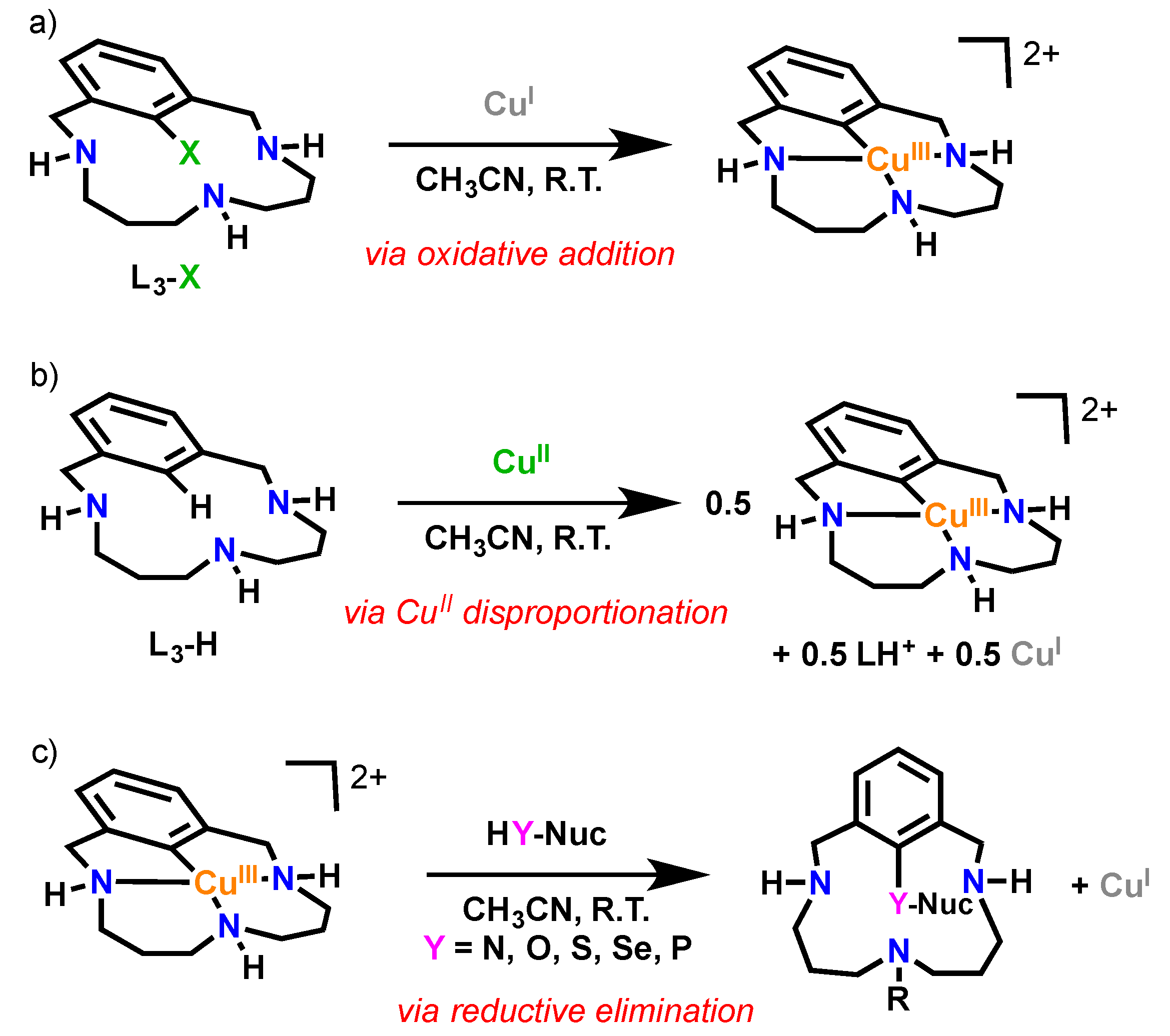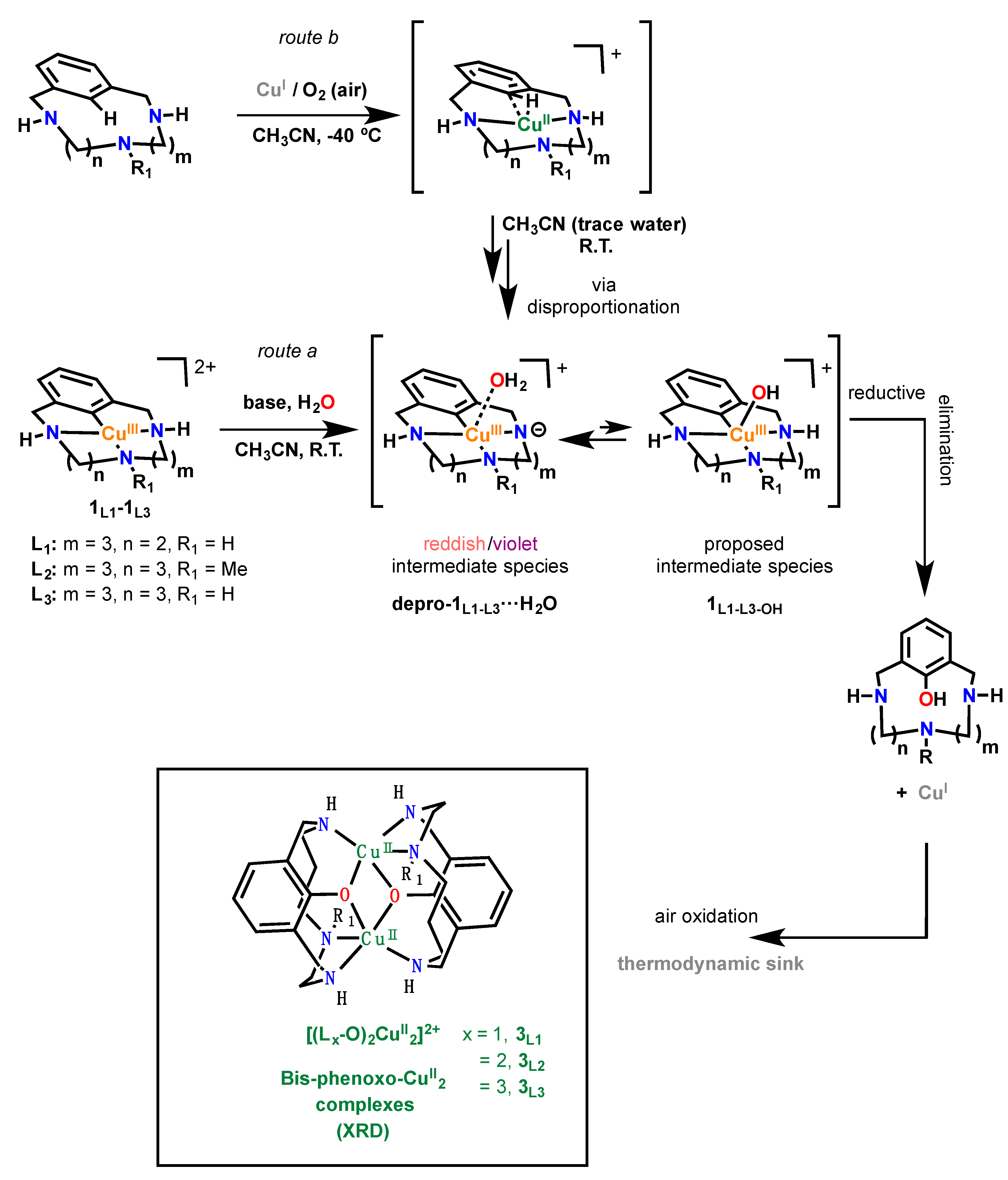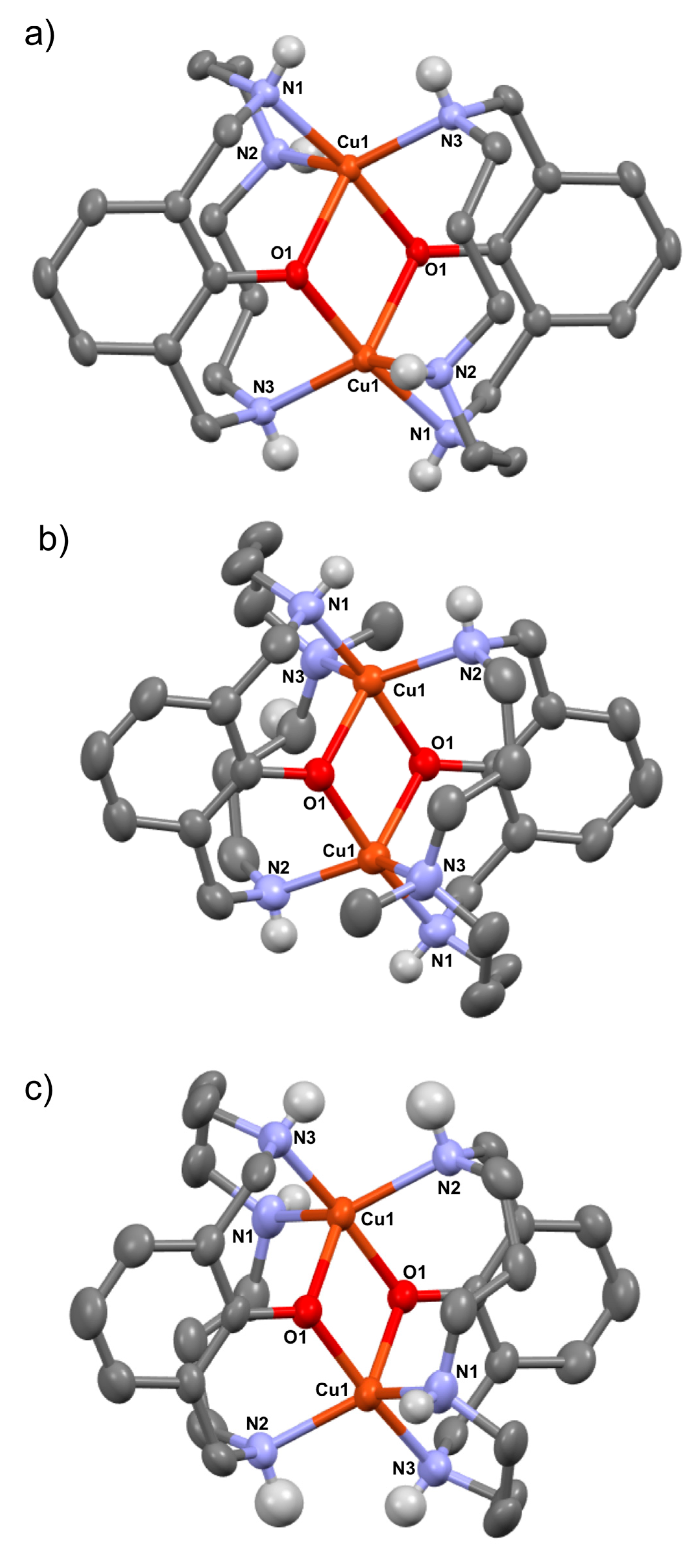Bis-Phenoxo-CuII2 Complexes: Formal Aromatic Hydroxylation via Aryl-CuIII Intermediate Species
Abstract
1. Introduction
2. Results and Discussion
2.1. Aryl-CuIII Complexes and Their Reactivity with Basic Water
2.2. X-ray Diffraction Analysis of the Bis-Phenoxo-CuII2 Complexes (3L1–3L3)
2.3. Mechanistic Investigation on the Aromatic Hydroxylation Reaction
2.4. Aromatic Hydroxylation via Arene C-H Activation with CuI/O2
3. Materials and Methods
4. Conclusions
Supplementary Materials
Author Contributions
Funding
Acknowledgments
Conflicts of Interest
References
- Ley, S.V.; Thomas, A.W. Modern synthetic methods for copper-mediated C(aryl)-O, C(aryl)-N, and C(aryl)-S bond formation. Angew. Chem. Int. Ed. 2003, 42, 5400–5449. [Google Scholar] [CrossRef] [PubMed]
- Tye, J.W.; Weng, Z.; Giri, G.; Hartwig, J.F. Copper(I) phenoxide complexes in the etherification of aryl halides. Angew Chem. Int. Ed. 2010, 49, 2185–2189. [Google Scholar] [CrossRef] [PubMed]
- Tye, J.W.; Weng, Z.; Johns, A.M.; Incarvito, C.D.; Hartwig, J.F. Copper complexes of anionic nitrogen ligands in the amidation and imidation of aryl halides. J. Am. Chem. Soc. 2008, 130, 9971–9983. [Google Scholar] [CrossRef] [PubMed]
- Shafir, A.; Lichtor, P.A.; Buchwald, S.L. N-versus O-arylation of aminoalcohols: Orthogonal selectivity in copper-based catalysts. J. Am. Chem. Soc. 2007, 129, 3490–3491. [Google Scholar] [CrossRef]
- Maiti, D.; Buchwald, S.L. Orthogonal Cu- and Pd-based catalyst systems for the O- and N-arylation of aminophenols. J. Am. Chem. Soc. 2009, 131, 17423–17429. [Google Scholar] [CrossRef]
- Jones, G.O.; Liu, P.; Houk, K.N.; Buchwald, S.L. Computational explorations of mechanisms and ligand-directed selectivities of copper-catalyzed ullmann-type reactions. J. Am. Chem. Soc. 2010, 132, 6205–6213. [Google Scholar] [CrossRef]
- Casitas, A.; Ribas, X. The role of organometallic copper(III) complexes in homogeneous catalysis. Chem. Sci. 2013, 4, 2301–2318. [Google Scholar] [CrossRef]
- Evano, G.; Blanchard, N.; Toumi, M. Copper-mediated coupling reactions and their applications in natural products and designed biomolecules synthesis. Chem. Rev. 2008, 108, 3054–3131. [Google Scholar] [CrossRef]
- Jiang, Y.; Ma, D. Modern Ullmann-Goldberg chemistry: Arylation of N-nucleophiles with aryl halides. In Copper-Mediated Cross-Coupling Reactions; Evano, G., Blanchard, N., Eds.; Wiley: Hoboken, Germany, 2014. [Google Scholar]
- Ribas, X.; Güell, I. Cu(I)/Cu(III) catalytic cycle involved in Ullmann-type cross-coupling reactions. Pure Appl. Chem. 2014, 86, 263–467. [Google Scholar] [CrossRef]
- Casitas, A.; King, A.E.; Parella, T.; Costas, M.; Stahl, S.S.; Ribas, X. Direct Observation of CuI/CuIII Redox Steps Relevant to Ullmann-Type Coupling Reactions. Chem. Sci. 2010, 1, 326–330. [Google Scholar] [CrossRef]
- Yao, B.; Wang, D.-X.; Huang, Z.-T.; Wang, M.-X. Room-temperature aerobic formation of a stable aryl-Cu(iii) complex and its reactions with nucleophiles: Highly efficient and diverse arene C-H functionalizations of azacalix[1]arene[3]pyridine. Chem. Commun. 2009, 2899–2901. [Google Scholar] [CrossRef] [PubMed]
- Yao, B.; Wang, Z.-L.; Zhang, H.; Wang, D.-X.; Zhao, L.; Wang, M.-X. Cu(ClO4)2-mediated arene C-H bond halogenations of azacalixaromatics using alkali metal halides as halogen sources. J. Org. Chem. 2012, 77, 3336–3340. [Google Scholar] [CrossRef] [PubMed]
- Wang, Z.-L.; Zhao, L.; Wang, M.-X. Construction of Caryl–Calkynyl Bond from Copper-Mediated Arene–Alkyne and Aryl Iodide–Alkyne Cross-Coupling Reactions: A Common Aryl-CuIII Intermediate in Arene C–H Activation and Castro–Stephens Reaction. Org. Lett. 2012, 14, 1472–1475. [Google Scholar] [CrossRef] [PubMed]
- Wang, Z.-L.; Zhao, L.; Wang, M.-X. Caryl-Calkyl bond formation from Cu(ClO4)2-mediated oxidative cross coupling reaction between arenes and alkyllithium reagents through structurally well-defined Ar-Cu(iii) intermediates. Chem. Commun. 2012, 48, 9418–9420. [Google Scholar] [CrossRef] [PubMed]
- Ribas, X.; Jackson, D.A.; Donnadieu, B.; Mahía, J.; Parella, T.; Xifra, R.; Hedman, B.; Hodgson, K.O.; Llobet, A.; Stack, T.D.P. Aryl C-H Activation by Cu(II) To Form an Organometallic Aryl-Cu(III) Species: A Novel Twist on Copper Disproportionation. Angew. Chem. Int. Ed. 2002, 41, 2991–2994. [Google Scholar] [CrossRef]
- Rovira, M.; Font, M.; Acuna-Pares, F.; Parella, T.; Luis, J.M.; Lloret-Fillol, J.; Ribas, X. Aryl-copper(III)-acetylides as key intermediates in Csp2-Csp model couplings under mild conditions. Chem. Eur. J. 2014, 20, 10005–10010. [Google Scholar] [CrossRef] [PubMed]
- Rovira, M.; Font, M.; Ribas, X. Model Csp2-Csp3 Hurtley Coupling Catalysis that Operates through a Well-Defined CuI/CuIII Mechanism. ChemCatChem 2013, 5, 687–691. [Google Scholar] [CrossRef]
- Casitas, A.; Canta, M.; Solà, M.; Costas, M.; Ribas, X. Nucleophilic Aryl Fluorination and Aryl Halide Exchange Mediated by a Cu(I)/Cu(III) Catalytic Cycle. J. Am. Chem. Soc. 2011, 133, 19386–19392. [Google Scholar] [CrossRef]
- King, A.E.; Huffman, L.M.; Casitas, A.; Costas, M.; Ribas, X.; Stahl, S.S. Copper-Catalyzed Aerobic Oxidative Functionalization of an Arene C-H Bond: Evidence for an Aryl-Copper(III) Intermediate. J. Am. Chem. Soc. 2010, 132, 12068–12073. [Google Scholar] [CrossRef]
- Casitas, A.; Poater, A.; Solà, M.; Stahl, S.S.; Costas, M.; Ribas, X. Molecular mechanism of acid-triggered aryl-halide reductive elimination in well-defined aryl-CuIII-halide species. Dalton Trans. 2010, 39, 10458–10463. [Google Scholar] [CrossRef]
- Bernoud, E.; Company, A.; Ribas, X. Direct use of CO2 for O-arylcarbamate synthesis via mild Cu(II)-catalyzed aerobic C-H functionalization in pincer-like macrocyclic systems. J. Organomet. Chem. 2017, 845, 44–48. [Google Scholar] [CrossRef]
- Xifra, R.; Ribas, X.; Llobet, A.; Poater, A.; Duran, M.; Solà, M.; Stack, T.D.P.; Benet-Buchholz, J.; Donnadieu, B.; Mahía, J.; et al. Fine-Tuning the Electronic Properties of Highly Stable Organometallic CuIII Complexes Containing Monoanionic Macrocyclic Ligands. Chem. Eur. J. 2005, 11, 5146–5156. [Google Scholar] [CrossRef] [PubMed]
- Rovira, M.; Jasikova, L.; Andris, E.; Acuna-Pares, F.; Soler, M.; Guell, I.; Wang, M.-Z.; Gomez, L.; Luis, J.M.; Roithova, J.; et al. A CuI/CuIII prototypical organometallic mechanism for the deactivation of an active pincer-like CuI catalyst in Ullmann-type couplings. Chem. Commun. 2017, 53, 8786–8789. [Google Scholar] [CrossRef]
- Rovira, M.; Soler, M.; Güell, I.; Wang, M.-Z.; Gómez, L.; Ribas, X. Orthogonal Discrimination among Functional Groups in Ullmann-Type C–O and C–N Couplings. J. Org. Chem. 2016, 81, 7315–7325. [Google Scholar] [CrossRef] [PubMed]
- Huffman, L.M.; Casitas, A.; Font, M.; Canta, M.; Costas, M.; Ribas, X.; Stahl, S.S. Observation and Mechanistic Study of Facile C-O Bond Formation between a Well-Defined Aryl-Copper(III) Complex and Oxygen Nucleophiles. Chem. Eur. J. 2011, 17, 10643–10650. [Google Scholar] [CrossRef]
- Monnier, F.; Taillefer, M. Catalytic C-C, C-N anf C-O Ullmann-Type Coupling Reactions. Angew. Chem. Int. Ed. 2009, 48, 6954–6971. [Google Scholar] [CrossRef] [PubMed]
- ten Brink, G.J.; Arends, I.W.C.E.; Sheldon, R.A. The Baeyer−Villiger Reaction: New Developments toward Greener Procedures. Chem. Rev. 2004, 104, 4105–4124. [Google Scholar] [CrossRef]
- Galli, C. Radical reactions of arenediazonium ions: An easy entry into the chemistry of the aryl radical. Chem. Rev. 1988, 88, 765–792. [Google Scholar] [CrossRef]
- Anderson, K.W.; Ikawa, T.; Tundel, R.E.; Buchwald, S.L. The Selective Reaction of Aryl Halides with KOH: Synthesis of Phenols, Aromatic Ethers, and Benzofurans. J. Am. Chem. Soc. 2006, 128, 10694–10695. [Google Scholar] [CrossRef]
- Yu, C.-W.; Chen, G.S.; Huang, C.-W.; Chern, J.-W. Efficient Microwave-Assisted Pd-Catalyzed Hydroxylation of Aryl Chlorides in the Presence of Carbonate. Org. Lett. 2012, 14, 3688–3691. [Google Scholar] [CrossRef]
- Maurer, S.; Liu, W.; Zhang, X.; Jiang, Y.; Ma, D. An Efficient Synthesis of Phenol via CuI/8-Hydroxyquinoline-Catalyzed Hydroxylation of Aryl Halides and Potassium Hydroxide. Synlett 2010, 2010, 976–978. [Google Scholar] [CrossRef]
- Xu, H.-J.; Liang, Y.-F.; Cai, Z.-Y.; Qi, H.-X.; Yang, C.-Y.; Feng, Y.-S. CuI-Nanoparticles-Catalyzed Selective Synthesis of Phenols, Anilines, and Thiophenols from Aryl Halides in Aqueous Solution. J. Org. Chem. 2011, 76, 2296–2300. [Google Scholar] [CrossRef] [PubMed]
- Fier, P.S.; Maloney, K.M. Reagent Design and Ligand Evolution for the Development of a Mild Copper-Catalyzed Hydroxylation Reaction. Org. Lett. 2017, 19, 3033–3036. [Google Scholar] [CrossRef] [PubMed]
- Shin, E.-J.; Kwon, G.-T.; Kim, S.-H. Room-Temperature Ionic Liquids (RTILs) as Green Media for Metal- and Base-Free ipso-Hydroxylation of Arylboronic Acids. Synlett 2019, 30, 1815–1819. [Google Scholar] [CrossRef]
- Zhang, Y.-H.; Yu, J.-Q. Pd(II)-Catalyzed Hydroxylation of Arenes with 1 atm of O2 or Air. J. Am. Chem. Soc. 2009, 131, 14654–14655. [Google Scholar] [CrossRef]
- Ribas, X.; Calle, C.; Poater, A.; Casitas, A.; Gómez, L.; Xifra, R.; Parella, T.; Benet-Buchholz, J.; Schweiger, A.; Mitrikas, G.; et al. Facile C-H Bond Cleavage via a Proton-Coupled Electron Transfer Involving a C-H···CuII Interaction. J. Am. Chem. Soc. 2010, 132, 12299–12306. [Google Scholar] [CrossRef]
- Addison, A.W.; Rao, T.N.; Reedijk, J.; Van Rijn, J.; Verschoor, G.C. Synthesis, structure, and spectroscopic properties of copper(II) compounds containing nitrogen-sulfur donor ligands: The crystal and molecular structure of aqua[1,7-bis(N-methylbenzimidazol-2′-yl)-2,6-dithiaheptane]copper(II) perchlorate. J. Chem. Soc. Dalton Trans. 1984, 7, 1349–1356. [Google Scholar] [CrossRef]
- Fusi, V.; Llobet, A.; Mahía, J.; Micheloni, M.; Paoli, P.; Ribas, X.; Rossi, P. A new Cu(I) complex that mimics the cresolase rection of tyrosinase. Crystal structure of its oxygenated Cu(II) complex. Eur. J. Inorg. Chem. 2002, 2002, 987–990. [Google Scholar] [CrossRef]
- Casitas, A.; Ioannidis, N.; Mitrikas, G.; Costas, M.; Ribas, X. Aryl-O reductive elimination from reaction of well-defined aryl-Cu(III) species with phenolates: The importance of ligand reactivity. Dalton Trans. 2011, 40, 8796–8799. [Google Scholar] [CrossRef]
- Ribas, X.; Xifra, R.; Parella, T.; Poater, A.; Solà, M.; Llobet, A. Regiospecific C-H Bond Activation: Reversible H/D Exchange Promoted by CuI Complexes with Triazamacrocyclic Ligands. Angew. Chem. Int. Ed. 2006, 45, 2941–2944. [Google Scholar] [CrossRef]
Sample Availability: Samples of the compounds 3L1–3L3 are available from the authors. |




| Entry | Reagents | Reaction Time (min) | Isolated Yield of 3L2 (%) |
|---|---|---|---|
| 1 | KOH (1 eq.), H2O (54 eq.) | 60 min | 65% |
| 2 | KOH (2 eq.), H2O (108 eq.) | 25 min | 8% |
| 3 | Proton Sponge (1 eq.), H2O (7 eq.) | 180 min | 53% |
| 4 | Proton Sponge (1 eq.) | 60 min | 0% |
| 5 | Proton Sponge (1 eq.), O2 (excess) | 240 min | 20% |
| 6 | H2O2 (3% in H2O) (1 eq.), H2O (52 eq.), Et3N (1 eq.) | 10 min | 31% |
| 7 | H2O2 (3% in H2O) (1 eq.), H2O (52 eq.) | 60 min | 0% |
| 8 | DABCO.2H2O2 (2 eq.) | 45 min | 15% |
| 9 | DABCO.2H2O2 (0.5 eq.) | 40 min | 40% |
© 2020 by the authors. Licensee MDPI, Basel, Switzerland. This article is an open access article distributed under the terms and conditions of the Creative Commons Attribution (CC BY) license (http://creativecommons.org/licenses/by/4.0/).
Share and Cite
Ribas, X.; Xifra, R.; Fontrodona, X. Bis-Phenoxo-CuII2 Complexes: Formal Aromatic Hydroxylation via Aryl-CuIII Intermediate Species. Molecules 2020, 25, 4595. https://doi.org/10.3390/molecules25204595
Ribas X, Xifra R, Fontrodona X. Bis-Phenoxo-CuII2 Complexes: Formal Aromatic Hydroxylation via Aryl-CuIII Intermediate Species. Molecules. 2020; 25(20):4595. https://doi.org/10.3390/molecules25204595
Chicago/Turabian StyleRibas, Xavi, Raül Xifra, and Xavier Fontrodona. 2020. "Bis-Phenoxo-CuII2 Complexes: Formal Aromatic Hydroxylation via Aryl-CuIII Intermediate Species" Molecules 25, no. 20: 4595. https://doi.org/10.3390/molecules25204595
APA StyleRibas, X., Xifra, R., & Fontrodona, X. (2020). Bis-Phenoxo-CuII2 Complexes: Formal Aromatic Hydroxylation via Aryl-CuIII Intermediate Species. Molecules, 25(20), 4595. https://doi.org/10.3390/molecules25204595







